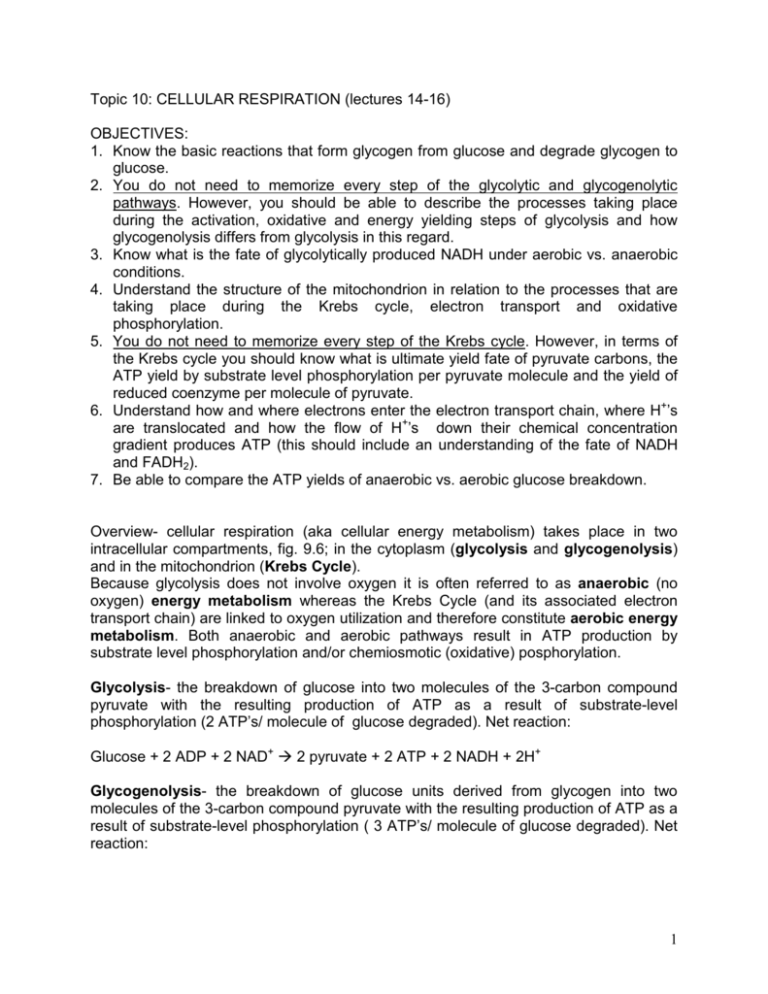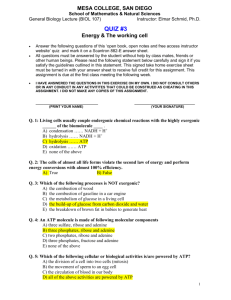Topic 10: CELLULAR RESPIRATION
advertisement

Topic 10: CELLULAR RESPIRATION (lectures 14-16) OBJECTIVES: 1. Know the basic reactions that form glycogen from glucose and degrade glycogen to glucose. 2. You do not need to memorize every step of the glycolytic and glycogenolytic pathways. However, you should be able to describe the processes taking place during the activation, oxidative and energy yielding steps of glycolysis and how glycogenolysis differs from glycolysis in this regard. 3. Know what is the fate of glycolytically produced NADH under aerobic vs. anaerobic conditions. 4. Understand the structure of the mitochondrion in relation to the processes that are taking place during the Krebs cycle, electron transport and oxidative phosphorylation. 5. You do not need to memorize every step of the Krebs cycle. However, in terms of the Krebs cycle you should know what is ultimate yield fate of pyruvate carbons, the ATP yield by substrate level phosphorylation per pyruvate molecule and the yield of reduced coenzyme per molecule of pyruvate. 6. Understand how and where electrons enter the electron transport chain, where H+’s are translocated and how the flow of H+’s down their chemical concentration gradient produces ATP (this should include an understanding of the fate of NADH and FADH2). 7. Be able to compare the ATP yields of anaerobic vs. aerobic glucose breakdown. Overview- cellular respiration (aka cellular energy metabolism) takes place in two intracellular compartments, fig. 9.6; in the cytoplasm (glycolysis and glycogenolysis) and in the mitochondrion (Krebs Cycle). Because glycolysis does not involve oxygen it is often referred to as anaerobic (no oxygen) energy metabolism whereas the Krebs Cycle (and its associated electron transport chain) are linked to oxygen utilization and therefore constitute aerobic energy metabolism. Both anaerobic and aerobic pathways result in ATP production by substrate level phosphorylation and/or chemiosmotic (oxidative) posphorylation. Glycolysis- the breakdown of glucose into two molecules of the 3-carbon compound pyruvate with the resulting production of ATP as a result of substrate-level phosphorylation (2 ATP’s/ molecule of glucose degraded). Net reaction: Glucose + 2 ADP + 2 NAD+ à 2 pyruvate + 2 ATP + 2 NADH + 2H+ Glycogenolysis- the breakdown of glucose units derived from glycogen into two molecules of the 3-carbon compound pyruvate with the resulting production of ATP as a result of substrate-level phosphorylation ( 3 ATP’s/ molecule of glucose degraded). Net reaction: 1 Glycogen(n glucose units) + 3 ADP + 2 NAD+ à Glycogen(n glucose units-1) + 2 pyruvate + 3 ATP + 2 NADH + 2H+ Digression on the biosynthesis and degradation of glycogen: glycogen is stored at times of energy surplus. During the day it accumulates in muscle and liver primarily. At night glycogen is burned as a fuel. BiosynthesisGlucose + ATP à Glucose-6-P + ADP Glucose-6-P à Glucose-1-P Glucose-1-P + UTP à UDPGlucose UDPGlucose + Glycogen(n glucose units)à Glycogen(n glucose units + 1) + Pi BreakdownGlycogen(n glucose units) à Glycogen(n glucose units-1) + Glucose-1-P The basic pathway of glycolysis is present in prokaryotic cells and in fungi, plant and animal cells. It can be divided into three basic phases (note your text only mentions two phases; I prefer to divide the so-called “energy pay-off phase into two phases): Fig. 9.8 (1) ATP investment phase- ATP is used to “activate” glucose and a glucose derivative (2) Oxidative phase- one of the glucose breakdown products is oxidized by NAD+ yielding NADH (3) ATP yielding phase- some of the energy associated with broken covalent bonds is trapped in the form of ATP Glycolysis- basic enzymatic steps (Fig. 9.9) (1) Hexokinase-activation (2) Phosphoglucoisomerase(3) Phosphofructokinase- continued activation (4) Aldolase- cleavage of 6-carbon cmpound into two 3 carbon compounds (5) Isomerase(6) Triose phosphate dehydrogenase- oxidative step (7) Phosphoglycerokinase- ATP yielding by substrate level phosphorylation (8) Phosphoglyceromutase(9) Enolase(10) Pyruvate kinase- ATP yielding by substrate level phosphorylation (NOTE: you are required to know reactions 1, 3, 6, 7 and 10) 2 Glycogenolysis - same basic steps except (1) hexokinase not necessary and (2) glucose-1-P is converted to glucose-6-phosphate Glycogen(n glucose units) à Glycogen(n glucose units-1) + Glucose-1-P Glucose-1-P à Glucose-6-P à Fructose-6-P à à à à à à à Pyruvate (phosphoglucomutase) Glycolysis viewed in phases (again): Activation: Hexokinase- glucose + ATP à glucose-6-P + ADP - ATP Phosphofructokinase- fructose-6-P + ATP à Fructose-1,6-BP + ADP - ATP Oxidative step: Triose phosphate dehydrogenase2 3-glyceraldehyde-P + 2 NAD+ + 2 Pi à 2 1,3-diphosphoglycerate + 2 NADH + 2 H+ + 2 NADH ATP yielding: Phosphoglycerokinase2 1,3-diphosphoglycerate + 2 ADP à 2 3-phosphoglycerate + 2 ATP + 2 ATP Pyuvate kinase2 phosphoenolpyruvate + 2 ADP à 2 pyruvate + 2 ATP + 2 ATP NET: 2 ATP + 2 NADH What about the NADH molecules? For glycolysis to function there must be continued supply of NAD+ for the oxidative step; under aerobic conditions the electrons from NADH are transferred to the mitochondrion where they eventually reduce oxygen to water (and also contribute to ATP production). We’ll talk about all this soon. What happens if there is no oxygen around? Anaerobic glycolysis takes place. Fig. 9.17 In most animals the enzyme lactate dehydrogenase (pyruvate + NADH à lactate + NAD+) produces lactate (which accumulates) and NAD+ which is then used in the oxidative step. In yeast the enzyme alcohol dehydrogenase ( acetaldehyde + NADH à ethyl alcohol + NAD+) produces ethyl alcohol (which accumulates) and NAD+ which is then used in the oxidative step. Fig. 9.18 – In presence of oxygen pyruvate is transported into the mitochondrion 3 Refresh your memory with the structure of the mitochondrion. Krebs Cycle- the complete catabolism of glucose to CO2 Under aerobic conditions pyruvate is transported into the mitochondrion (fig. 9.10); a large protein complex called pyruvate dehydrogenase consisting of several enzymes removes a CO2 and forms a compound known as acetyl-S-CoA. This compound then enters the Krebs cycle (fig. 9.11). Krebs Cycle - series of metabolic intraconversions which ultimately forms CO2 from the two carbons of acetyl-S-CoA as well as 1 ATP/ molecule of acetyl-S-CoA and 4 reduced conenzyme molecules/ molecule of acetyl-S-CoA. It is called a cycle because most of the intermediates (reactants; metabolites) do not change in concentration but are regenerated. 1. Citrate synthase- entry step; acetyl-S-CoA (2 carbons) combines with oxaloacetate (4 carbons) to form citrate (6 carbons) 2. citrate à isocitrate 3. isocitrate à a-ketoglutarate (5 carbons)- oxidative decarboxylation yields NADH 4. a-ketoglutarate à succinyl-S-CoA (4 carbons)- oxidative decarboxylation yield NADH; Coenzyme A added 5. succinyl-S-CoA à succinate- oxidative step produces FADH2 6. succinate à fumarate 7. fumarate à malate 8. malate à oxaloacetate- oxidative step produces NADH fig. 9.12- shows yield for each pyruvate (actually acetyl-S-CoA) molecule in the KREBS CYCLE: 2 CO2, 1 ATP, 3 NADH and 1 FADH2. This yield is doubled if you take into account the fact that there are two pyruvates per glucose molecule! The NADH and FADH2 molecules play an important role in ATP production. Recall that in redox reactions electrons are transferred from less electronegative to more electronegative compounds and that this process results in a decrease in free energy. Both NADH and FADH2 are not particularly electronegative and they readily transfer their electrons to molecules embedded in the matrix side of the inner mitochondrial membrane. The electrons are then transferred to more electronegative compounds in what is known as the electron transport chain (fig. 9.13) ultimately reducing oxygen to water. Note that they enter at different positions in the electron transport chain and that the further the electrons travel, the greater the decrease in free energy. How is this decrease in free energy “trapped” and eventually converted to ATP? Chemiosmotic energy coupling mechanism (fig. 9.14): Fig. 9.15- electron transport chain 4 1. the inner mitochondrial membrane is impermeable to H+’s 2. as electrons are transported down the electron transport chain, H+’s are transported from the matrix to the intermembrane space; electrons from NADH pump more H+’s than electrons from FADH2 3. this creates a transmembrane gradient in which the concentration of H+’s is much higher in the intermembrane space than in the matrix; in effect, a pH gradient is generated (gradient often referred to as proton motive force). 4. the movement of H+’s downhill is a higly spontaneous process; the only way the H+’s can enter the matrix is through a protein complex called ATP synthase. 5. the thermodynamically favorable influx of drives the synthesis of ATP by the synthase; 3 ATP’s for each NADH and 2 ATP’s for each FADH2. 6. ATP exits the matrix through a protein transporter known as the adenine nucleotide translocase fig. 9.16: net yield of ATP synthesis as a result of complete oxidation- roughly 36-38 (depending on who you talk to) ATP/molecule of glucose as opposed to 2 ATP/molecule of glucose for anaerobic glycolysis. Catabolism of other organic substrates (fig. 9.19) (1) amino acids- the amino group (NH3) is removed and the carbon skeleton enters into the catabolic pathway at the level of pyruvate, acetyl-S-CoA or a Krebs cycle inetermediate. (2) Fats- enzymes lipase cleaves fats into glycerol and fatty acids -glycerol enters the glycolytic pathway -fatty acids are broken down by b-oxidation, a process which sequentially cleaves two carbon fragments ( enters into Krebs cycle as acetyl-S-CoA) Control of cellular respiration- the rate of cellular respiration is exquisitely controlled. As rate of ATP use increases, there is a proportionate increase in the rate of ATP production and vice versa. 5







